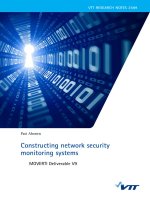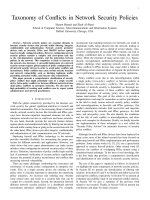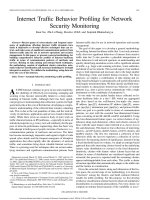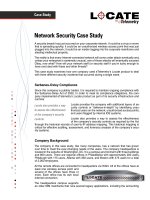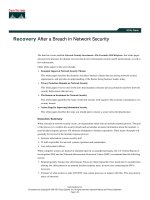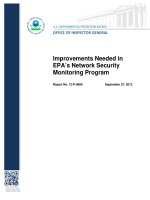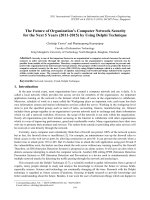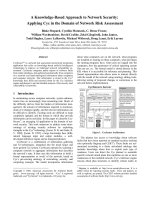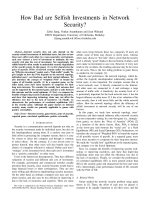Improvements Needed in EPA’s Network Security Monitoring Program pdf
Bạn đang xem bản rút gọn của tài liệu. Xem và tải ngay bản đầy đủ của tài liệu tại đây (280.76 KB, 33 trang )
Improvements Needed in
EPA’s Network Security
Monitoring Program
Report No. 12-P-0899 September 27, 2012
U.S.ENVIRONMENTALPROTECTIONAGENCY
OFFICEOFINSPECTORGENERAL
Scan this mobile
code to learn more
about the EPA OIG.
Report Contributors: Rudolph M. Brevard
Cheryl Reid
Vincent Campbell
Neven Soliman
Kyle Denning
Abbreviations
ASSERT Automated System Security Evaluation and Remediation Tracking
CERT Computer Emergency Response Team
CSIRC Computer Security Incident Response Capability Center
CTS Customer Technology Solutions
EPA U.S. Environmental Protection Agency
ISO Information Security Officer
IT Information Technology
NCC National Computer Center
NIST National Institute of Standards and Technology
OEI Office of Environmental Information
OIG Office of Inspector General
OTOP Office of Technology Operations and Planning
POA&M Plans of Actions and Milestones
SIEM Security Incident and Event Management
SP Special Publication
TISS Technology and Information Security Staff
Hotline
To report fraud, waste, or abuse, contact us through one of the following methods:
e-mail:
phone:
fax:
online:
1-888-546-8740
202-566-2599
write:
EPA Inspector General Hotline
1200 Pennsylvania Avenue NW
Mailcode 2431T
Washington, DC 20460
12-P-0899
September 27, 2012
Why We Did This Review
The U.S. Environmental
Protection Agency (EPA) Office
of Inspector General (OIG)
conducted this audit to
(1) identify which tools EPA
uses to identify, analyze, and
resolve cyber-security
incidents; (2) identify steps
implemented to resolve known
weaknesses in its incidence
response capabilities; and
(3) evaluate how users report
security incidents.
Continually monitoring network
threats through intrusion
detection and prevention
systems and other mechanisms
is essential. Establishing clear
procedures for assessing the
current and potential business
impact of incidents is critical, as
is implementing effective
methods of collecting,
analyzing, and reporting data.
This report addresses the
following EPA Goal or
Cross-Cutting Strategy:
Strengthening EPA’s
Workforce and Capabilities
For further information, contact
our Office of Congressional and
Public Affairs at (202) 566-2391.
The full report is at:
www.epa.gov/oig/reports/2012/
20120927-12-P-0899.pdf
Improvements Needed in EPA’s
Network Security Monitoring Program
What We Found
EPA’s deployment of a Security Incident and Event Management (SIEM) tool did
not comply with EPA’s system life cycle management procedures, which require
planning project activities to include resources needed, schedules, and structured
training sessions. EPA did not develop a comprehensive deployment strategy for
the SIEM tool to incorporate all of EPA’s offices or a formal training program on
how to use the tool. When EPA staff are not able to use an information technology
investment, the investment has limited value in meeting organizational goals and
users’ needs.
EPA does not have a computer security log management policy consistent with
federal requirements. While EPA has a policy governing minimum system auditing
activities to be logged, EPA has yet to define a policy for audit log storage and
disposal requirements along with log management roles and responsibilities. EPA
risks not having logged data available when needed, and program officials may
not implement needed security controls.
EPA did not follow up with staff to confirm whether corrective actions were taken
to address known information security weaknesses. EPA had not taken steps to
address weaknesses identified from internal reviews as required. Known
vulnerabilities that remain unremediated could leave EPA’s information and
assets exposed to unauthorized access.
Recommendations and Planned Agency Corrective Actions
We recommended that the Assistant Administrator for Environmental Information
develop and implement a strategy to incorporate EPA’s headquarters program
offices within the SIEM environment, develop and implement a formal training
program for the SIEM tool, develop a policy or revise the Agency’s Information
Security Policy to comply with audit logging requirements, and require that the
Senior Agency Information Security Officer be addressed on all Office of
Environmental Information security reports and reviews.
Office of Environmental Information officials concurred with and agreed to take
corrective actions to address all recommendations.
Noteworthy Achievements
We found that EPA employees are aware of the reporting procedures for when
they experience an information security incident. Additionally, EPA has recently
deployed technical tools to combat cyber-security attacks and conduct forensic
analyses of security activity.
U.S. Environmental Protection Agency
Office of Inspector General
At a Glance
September 27, 2012
MEMORANDUM
SUBJECT: Improvements Needed in EPA’s Network Security Monitoring Program
Report No. 12-P-0899
FROM: Arthur A. Elkins, Jr.
TO: Malcolm D. Jackson
Assistant Administrator for Environmental Information and
Chief Information Officer
This is our report on the subject audit conducted by the Office of Inspector General (OIG) of the
U.S. Environmental Protection Agency (EPA). This report contains findings that describe the
problems the OIG has identified and corrective actions the OIG recommends. This report
represents the opinion of the OIG and does not necessarily represent the final EPA position.
Final determinations on matters in this report will be made by EPA managers in accordance with
established audit resolution procedures.
Action Required
In accordance with EPA Manual 2750, you are required to provide a written response to this
report within 90 calendar days. You should include a corrective action plan for agreed-upon
actions, including milestone dates. Recommendations marked unresolved due to a "TBD"
planned completion date require a milestone date. Your response will be posted on the OIG’s
public website, along with our memorandum commenting on your response. Your response
should be provided as an Adobe PDF file that complies with the accessibility requirements of
Section 508 of the Rehabilitation Act of 1973, as amended. The final response should not contain
data that you do not want to be released to the public; if your response contains such data, you
should identify the data for redaction or removal. We have no objections to the further release of
this report to the public. We will post this report to our website at />.
If you or your staff has any questions regarding this report, please contact Patricia Hill, Assistant
Inspector General, Office of Mission Systems, at (202) 566-0894 or ; or
Rudolph M. Brevard, Director, Information Resources Management Assessments, at
(202) 566-0893 or
UNITED STATES ENVIRONMENTAL PROTECTION AGENCY
WASHINGTON, D.C. 20460
THE INSPECTOR GENERAL
Improvements Needed in EPA’s 12-P-0899
Network Security Monitoring Program
Chapters
1 Introduction 1
Purpose 1
Background 1
Noteworthy Achievements 2
Scope and Methodology 2
2 Security Incident and Event Management Tool Deployment
Lacks Key Activities 4
Headquarters Offices Need a SIEM Tool Implementation Strategy 4
Training on SIEM Tool’s Utilities Needs Improvements 5
Recommendations 6
Agency Comments and OIG Evaluation 6
3 Improvements Needed in EPA’s Computer Security Log
Management Practices 7
EPA Policy Lacks Some Log Management Requirements 7
Log Management Infrastructure Lacks Approved Roles and
Responsibilities 8
Recommendations 8
Agency Comments and OIG Evaluation 8
4 EPA Lacks an Oversight Process to Remediate Information
Security Weaknesses 9
EPA Did Not Address Recommendations From Internal Reviews 9
National Computer Center Does Not Follow Up on
Internally Conducted Network Scans 11
Recommendations 12
Agency Comments and OIG Evaluation 12
Status of Recommendations and Potential Monetary Benefits 13
A EPA Monitoring Tools Reviewed 14
B Unaddressed Recommendations 15
C Agency Response to Draft Report 21
D Distribution 28
Table of Contents
Appendices
12-P-0899 1
Chapter 1
Introduction
Purpose
We sought to determine:
What tools has the U.S. Environmental Protection Agency (EPA)
implemented to increase its capability to promptly identify, analyze, and
resolve cyber-security incidents against the Agency’s network?
What steps has EPA implemented to resolve known weaknesses in its
incident response capability?
Could EPA make improvements in how users report security incidents?
Background
A computer security incident is a violation or threat of a violation of computer
security policies or standard security practices. Computer security-related threats
have not only increased and become more diverse, but can cause more damage.
Preventive actions based on risk assessments can lower the number of incidents,
but not all incidents can be prevented. An incident response capability is needed
for the quick detection of incidents and to minimize loss and destruction of data,
mitigate the weaknesses that were exploited, and restore computing services.
Continual monitoring of threats through intrusion detection and prevention
systems and other mechanisms is essential. Establishing clear procedures to assess
current and potential business impacts of incidents is critical, as is putting in place
effective methods to collect, analyze, and report data.
The Assistant Administrator for Environmental Information, who is also EPA’s
Chief Information Officer, is charged under the Federal Information Security
Management Act with providing leadership to ensure the security of EPA’s
information technology (IT) resources. The Assistant Administrator for
Environmental Information designates a Senior Agency Information Security
Officer, who is responsible for managing Agency compliance with federal
information security requirements.
EPA’s Office of Technology Operations and Planning (OTOP), within the Office
of Environmental Information (OEI), is responsible for the policy, management,
and implementation of EPA’s IT infrastructure. Within OTOP, Technology and
Information Security Staff (TISS) are responsible for managing the operation of
EPA’s IT security program. TISS is responsible for deploying and managing
EPA’s Security Incident and Event Management (SIEM) tool. SIEM documents
show that EPA’s information security staff can use the SIEM tool to (1) comply
with federally required log review and correlation activities, and (2) reduce the
12-P-0899 2
level of effort on administrative staff. TISS acquired a SIEM tool in May 2010.
TISS documentation indicates that the SIEM tool would be used to perform real-
time analysis of security alerts to help respond to security attacks faster and create
log security data and compliance reports.
During years 2010-2011, EPA invested over $4.1 million in several automated
tools to strengthen the security of the Agency’s network infrastructure. OEI,
Region 7, and Region 8 information security personnel manage the tools we
reviewed. See Appendix A for additional details on these tools.
EPA uses the Automated System Security Evaluation and Remediation Tracking
(ASSERT) system to prepare Federal Information Security Management Act
reports. ASSERT provides systems owners and managers with an understanding
of the system’s risks, security controls needed to address risks, and a plan of
actions and milestones to remediate risks.
Noteworthy Achievements
We found that EPA employees are aware of reporting procedures for when they
experience an information security incident. OTOP deployed forensic and SIEM
tools to strengthen EPA network monitoring. OTOP staff indicated that the
forensic tool could be used to identify rogue executable files on EPA
workstations. TISS documentation indicated that the SIEM tool performs real-
time analysis of security alerts, and is available for EPA’s information security
staff to perform audit logging.
Scope and Methodology
Our audit work commenced March 2011 and was completed in June 2012. We
conducted our audit work at EPA headquarters in Washington, DC; National
Computer Center, Research Triangle Park, North Carolina; Region 7 headquarters
in Kansas City, Kansas; and Region 8 headquarters in Denver, Colorado. We
conducted this audit in accordance with generally accepted government auditing
standards. Those standards require that we plan and perform the audit to obtain
sufficient, appropriate evidence to provide a reasonable basis for our findings and
conclusions based on our audit objectives. We believe that the evidence obtained
provides a reasonable basis for our findings and conclusions based on our audit
objectives.
We reviewed federal regulations and EPA policies and procedures. We collected
and reviewed purchase orders and contract agreements, but did not conduct any
tests to determine whether contractors complied with contract terms and
conditions. We interviewed EPA headquarters and regional information security
staff on technical tools used to monitor and analyze network traffic. We obtained
an understanding of each tool’s use, purpose, cost, and function. We did random
12-P-0899 3
interviews of headquarters and regional staff to assess their knowledge for
reporting incidents.
We conducted follow-up on two prior EPA Office of Inspector General (OIG)
security audits on EPA’s network security monitoring program.
In EPA OIG Report No. 2005-P-00011 Security Configuration and
Monitoring of EPA’s Remote Access Methods Need Improvement, dated
March 22, 2005, we recommended that OTOP develop and implement a
security-monitoring program that includes testing all servers.
In 2009, we followed up on the above report in EPA OIG Report No.
09-P-0240, Project Delays Prevent EPA from Implementing an Agency-
wide Information Security Vulnerability Management Program, dated
September 21, 2009. We had sought to determine whether the Agency had
implemented an Agency-wide network security monitoring program. We
concluded that EPA still had not established an Agency-wide network
security monitoring program because EPA did not take alternative action
when the monitoring project experienced significant delays. Additionally,
EPA offices did not regularly evaluate the effectiveness of actions taken to
correct identified deficiencies as required by the Office of Management
and Budget.
12-P-0899 4
Chapter 2
Security Incident and Event Management Tool
Deployment Lacks Key Activities
EPA’s deployment of a SIEM tool did not comply with Agency requirements for
deploying IT investments. EPA's system life cycle management procedures
require planning project activities to include resources needed, schedules, and
structured training sessions. In particular, EPA had not taken steps to ensure the
successful implementation of the SIEM tool by putting in place processes to
manage the turnover of key personnel critical to the project's success, making sure
plans included all EPA offices, ensuring all responsible individuals have access to
management reports generated by the tool, maintaining communications with
EPA offices to ensure they were informed of the tool's deployment schedule, and
providing training so that offices could use the tool once it was implemented in
their respective offices. Without having such plans in place, EPA risks that the
SIEM tool would not provide effective network monitoring. When EPA staff are
not able to use an IT investment, that investment has limited value in meeting
organizational goals and users’ needs.
Headquarters Offices Need a SIEM Tool Implementation Strategy
TISS lacks a fully developed strategy to include EPA’s headquarters program
offices within the SIEM’s environment. TISS’s documents showed a strategy that
included each of EPA’s regional offices within the SIEM’s environment.
However, efforts to include headquarters program offices fell short due to
turnover of technical staff and TISS having discontinued meetings with program
office staff on using the SIEM tool. As such, ten program offices do not have their
headquarters servers logged by the SIEM tool.
Although regional information security officers (ISOs) have access to review
daily log activity and receive daily log reports, ten headquarters ISOs do not have
access to the SIEM tool or receive the daily reports. Each program office manages
numerous assets connected to EPA’s network, with some assets containing
sensitive information such as personally identifiable information.We interviewed
several headquarters ISOs who expressed interest in using the SIEM tool, but they
said barriers have hindered the use of the SIEM tool in their office. Specifically,
they cited a lack of (a) access to the tool, (b) demonstration of the tool’s
capabilities, and (c) follow-up communication from TISS.
TISS management stated that bringing devices within the SIEM architecture is
based on a first-come, first-serve basis. TISS had not developed a strategy that
included a priority list based on EPA’s mission-critical and business processes.
12-P-0899 5
Such an approach would have provided TISS a systematic approach for including
each program within the SIEM’s architecture based on the level of risk.
With a majority of EPA’s program offices not using the SIEM tool to monitor
security of their assets, the assessment of the security controls associated with log
reviews and event correlations may not be as efficient and effective compared to
those EPA offices using the SIEM’s robust technology. Also, headquarters
program offices do not have access to an automated tool that could provide an
extra level of analysis to help with recognizing patterns and relationships within
data that may escape manual analyses.
TISS provided an updated project plan in February 2012. However, milestone
dates have not been finalized as to when headquarters program offices will be
incorporated within the SIEM architecture.
Training on SIEM Tool’s Utilities Needs Improvements
TISS did not develop a structured training plan to use with the SIEM tool. EPA’s
system life cycle management procedures require the development of a training
plan and user manual when training users of new IT investments. The training
plan should outline objectives, target audience, strategies, and curriculum.
TISS conducted informal training sessions with EPA’s regional ISOs to address
questions on tool usage and how to generate reports. Those sessions did not include
written agendas or discussion topics. Regional ISOs said that the training sessions
needed more emphasis on how the SIEM tool could be used to perform detailed
security analyses. Further, headquarters ISOs were not aware of the training
sessions. TISS said the training sessions were stopped due to staff changes.
TISS also sends daily SIEM reports to EPA’s ISOs for review and analysis.
However, EPA’s ISOs stated the files were too large to perform detailed analyses
and were limited to spreadsheet queries. Some ISOs said they want to be able to
filter the log data by event type. The ISOs can create custom reports if they know
programming language. TISS had not created a user guide on how to generate
security reports, which the ISOs stated would be of immense value in obtaining
hands-on experience with the SIEM tool.
Without a structured training curriculum, users’ needs are not being met and the
continued use of the SIEM tool by EPA’s information security staff will be of
limited value in performing information security activities.
12-P-0899 6
Recommendations
We recommend that the Assistant Administrator for Environmental Information:
1. Develop and implement a strategy with milestone dates to incorporate
EPA’s headquarters program offices within the SIEM environment.
2. Develop and implement a formal training program that will meet EPA’s
information security staff needs in using the SIEM tool. The training
program should include a user guide on using the SIEM tool to generate
reports and developing customized reports for filtering known and
suspicious events.
Agency Comments and OIG Evaluation
OEI officials concurred with and agreed to take corrective actions to address all
recommendations. We believe these corrective actions, when implemented, will
address the intent of our recommendations.
Appendix C contains the Agency’s complete response to the report.
12-P-0899 7
Chapter 3
Improvements Needed in EPA’s
Computer Security Log Management Practices
EPA does not have a computer security log management policy that complies
with federal requirements. While EPA has a policy governing minimum system
auditing activities to be logged, EPA has yet to define a policy for audit log
storage and disposal requirements. EPA recently implemented its SIEM tool.
However, the Agency has yet to finalize its guidance to govern the roles and
responsibilities for the log management infrastructure. The National Institute of
Standards and Technology (NIST) requires agencies to define mandatory
requirements for these activities. Without activity definitions, EPA risks logged
data not being available when needed for event analysis. Furthermore, without
clearly defined roles and responsibilities for the log management infrastructure,
EPA risks having program office officials responsible for securing their systems
not implement needed security controls for log management.
EPA Policy Lacks Some Log Management Requirements
Three sites visited had audit logging procedures, but none of the sites had
consistent procedures. For example, one site’s procedures did not include
requirements for proper log storage and disposal, while the other sites had
inconsistent storage and disposal procedures. NIST Special Publication (SP)
800-92, “Guide to Computer Security Log Management,” dated September 2006,
states that an organization should develop policies that clearly define mandatory
requirements for log management activities including log generation, log storage
and disposal, and log analysis.
EPA offices defined and implemented their own respective logging procedures
because the Agency’s policy does not define mandatory audit logging
requirements. EPA issued an Interim Agency Information Security Policy in April
2012 to supersede its Agency Network Security Policy, however this policy still
does not address key log management elements such as proper log storage and
disposal. The lack of a clearly defined audit logging policy could lead additional
EPA offices to create inconsistent logging practices across the Agency, and may
jeopardize the availability of EPA’s logging information when needed for
investigating suspicious activity that may not be monitored by the SIEM tool.
12-P-0899 8
Log Management Infrastructure Lacks Approved Roles and
Responsibilities
While EPA defined the roles and responsibilities for the SIEM infrastructure
within the draft “Enterprise Reference Guide” dated June 2011, the Agency has
yet to finalize these requirements. NIST SP 800-92 states that as part of the log
management planning process, an organization should define the roles and
responsibilities of individuals and teams expected to be involved in log
management.
We found that EPA had not developed a policy to define the roles and
responsibilities for log management. We believe that the lack of a policy to
reinforce how EPA would use the SIEM infrastructure to comply with the log
review requirements of NIST SP 800-53, “Recommended Security Controls for
Federal Information Systems,” contributed to the issues identified in chapter 2 of
this report. Furthermore, EPA intended the SIEM tool to be used to provide
information beyond what is required to meet basic NIST SP 800-53 log review
requirements. Without a clearly defined policy outlining respective roles within
the log management infrastructure, the SIEM tool may not meet its intended
purpose.
Recommendations
We recommend that the Assistant Administrator for Environmental Information:
3. Develop a policy or revise the Agency’s Information Security Policy to
comply with NIST SP 800-92. This policy should include, but not be
limited to, defining log storage and disposal requirements and roles and
responsibilities for the log management infrastructure.
4. Finalize the SIEM tool’s “Enterprise Reference Guide.”
Agency Comments and OIG Evaluation
OEI officials concurred with and agreed to take corrective actions to address all
recommendations. We believe these corrective actions, when implemented, will
address the intent of our recommendations. OEI officials also listed “TBD” (to be
determined) for the planned completion date for recommendation 3. We list the
status of this recommendation as unresolved. In our transmittal memorandum, we
request OEI officials to provide milestone dates in the 90-day response.
Appendix C contains the Agency’s complete response to the report.
12-P-0899 9
Chapter 4
EPA Lacks an Oversight Process to Remediate
Information Security Weaknesses
EPA did not follow up with staff to confirm that corrective actions were taken to
address known information security weaknesses. EPA had not addressed
weaknesses identified by internal reviews. Office of Management and Budget
Circular A-123, “Management Accountability and Control,” states managers are
responsible for taking timely and effective actions to correct identified
deficiencies. OEI, which is responsible for securing EPA’s network from internal
and external exploits, has not developed a process to verify that known
weaknesses have been addressed. As a result, known vulnerabilities remained
unremediated and key steps to resolve those weaknesses remain unaddressed,
which could leave EPA information exposed to unauthorized access.
EPA Did Not Address Recommendations From Internal Reviews
From 2009 to 2010, three internal reviews were conducted on EPA’s information
security program. EPA prepared an internal document titled “Clampi Infection
Lessons Learned Document” that summarized EPA’s response to a Trojan horse
infection. A Trojan horse is a computer program that is hiding a virus or other
potentially damaging program. A Trojan horse can be a program that purports to
do one action when, in fact, it is performing a malicious action on a computer.
Trojan horses can be included in software that is downloaded for free or as
attachments in email messages. EPA contracted with the Computer Emergency
Response Team (CERT) Program at the Carnegie Mellon University’s Software
Engineering Institute and with Booz Allen Hamilton to conduct separate reviews
of EPA’s information security program. We found proper points of contacts were
difficult to obtain and plans of actions and milestones (POA&Ms) were either not
created or were not created until our audit was underway. EPA’s POA&Ms
procedures state that any IT security finding and recommendation from reviews,
audits, assessments, tests, or other sources (including but not limited to incidents),
must be analyzed and categorized as to the level of risk (high, medium, low) and a
determination made for appropriate action to be taken for the weaknesses
identified. Table 1 identifies the names of the reports and the number of
recommendations reviewed, not addressed, and without POA&Ms.
12-P-0899 10
Table 1: Three internal reports reviewed with status of recommendations
Title of Agency internal review
No. of report
recommendations
No. of
recommendations
not addressed
No. of
recommendations
without POA&Ms
Clampi Infection Lessons
Learned
53 6 7
Carnegie Mellon 31 17 31
Booz Allen Hamilton 19 0 19
Totals 103 23 57
Source: Clampi Infection Lessons Learned document, Carnegie Mellon report, and Booz Allen Hamilton report. OIG-
generated.
The Clampi Infection Lessons Learned document resulted from a Trojan horse
infection that occurred within EPA in July 2009. Based on meetings with EPA, we
found that there was no central point of contact responsible to ensure EPA staff
addressed each recommendation. In some cases, EPA staff could not provide any
evidence on how the issues and recommendations were addressed. We also found
that some recommendations were not addressed and, in some cases, POA&Ms were
created after we started fieldwork, or 2 years after the Clampi Infection occurred.
The Carnegie Mellon report, issued in August 2009, appraised six areas within
EPA’s information security program using the CERT Resiliency Engineering
Framework. We found that EPA’s management had neither taken corrective
actions nor created POA&Ms to address the findings. As a result of our findings,
TISS developed a strategic plan covering fiscal years 2011 through 2016 to
manage the report’s findings. We found that the strategic plan addressed sections
of the report except for issues on global strengths and weaknesses. We also found
that POA&Ms were not created for other areas reviewed.
The Booz Allen Hamilton document, issued in August 2010, identified
procedural and operational deficiencies with EPA’s incident handling capabilities
when dealing with Advanced Persistent Threats. These threats are adversaries
who can bypass virtually all of today’s best practices and have the ability to
establish and maintain a long-term presence on target networks. When we
followed up on the issues, TISS developed a strategic plan to address the report’s
findings. Although the strategic plan did not include an authoritative corrective
action plan, we considered the strategic plan a managerial approach to remediate
known weaknesses. TISS had not created POA&Ms in EPA’s ASSERT system to
manage the document’s findings and to ensure accountability is assigned.
Appendix B identifies the documents’ findings and recommendations that remain
unaddressed.
12-P-0899 11
National Computer Center Does Not Follow Up on Internally
Conducted Network Scans
OEI does not require system owners to provide a response on how they addressed
vulnerabilities identified during monthly network testing. Further, OEI does not
follow up with system owners to confirm that identified vulnerabilities have been
addressed. Office of Management and Budget’s Circular A-123 requires managers
to take timely and effective action to correct deficiencies identified by a variety of
sources. The circular also states that correcting deficiencies is an integral part of
management accountability and must be considered a priority by the Agency.
National Computer Center (NCC) staff stated that it was not their responsibility to
ensure that the vulnerabilities are addressed. Therefore, there is no assurance that
identified vulnerabilities are being addressed or monitored, which could expose
EPA’s network to security attacks.
In EPA OIG Report No. 2005-P-00011, Security Configuration and Monitoring of
EPA’s Remote Access Methods Need Improvement, dated March 22, 2005, we
recommended that OTOP develop and implement a security-monitoring program
that includes testing all servers. Further, in EPA OIG Report No. 09-P-0240,
Project Delays Prevent EPA from Implementing an Agency-wide Information
Security Vulnerability Management Program, dated September 21, 2009, we
concluded that EPA still had not established an Agency-wide network security
monitoring program because EPA did not take alternative action when the
monitoring project experienced significant delays.
We looked at the NCC Foundstone tool during the conduct of this audit and found
that OEI’s NCC staff conduct monthly vulnerability scans of EPA’s network and
forward scan results to the appropriate contacts for action. However, NCC staff do
not follow up nor require system owners to respond so that NCC can confirm that
scan results have been addressed. NCC staff stated they provide the tools and the
support but regional and program office staff are responsible for taking action.
NCC staff does not rescan those servers at a later date to confirm vulnerabilities
were remediated. We made our initial recommendation in 2005 but an EPA-wide
vulnerability management and remediation process is still not in place. Therefore,
there is no assurance that EPA’s information security staff is remediating
vulnerabilities in a timely manner, and such vulnerabilities could expose EPA’s
assets to unauthorized access and potential harm to the network.
12-P-0899 12
Recommendations
We recommend that the Assistant Administrator for Environmental Information:
5. Issue a memorandum to OEI officials requiring the Senior Agency
Information Security Officer be the addressee on all internal security
reports and reviews in order to ensure identified weaknesses are recorded
within the Agency’s security weakness tracking system.
6. Create POA&Ms for all recommendations applicable to Agency internal
reports identified in Appendix B.
7. Develop and implement a process to verify that identified weaknesses in
Appendix B are addressed and decisions are documented on actions taken.
8. Develop and implement a process to verify that regions and program
office staff address vulnerabilities from NCC scans.
Agency Comments and OIG Evaluation
OEI officials concurred with recommendations 6 through 8. Recommendation 5
originally required a written appointment of a central point of contact for tracking
the completion of weaknesses discovered during internal assessments. In its
response, OEI stated that the Agency’s Senior Agency Information Security
Officer is appointed as the central Agency contact for tracking remediation action.
However, our audit work disclosed that the points of contact were difficult to
obtain and POA&Ms were not created. We modified our recommendation to state
that the Assistant Administrator for Environmental Information and Chief
Information Officer should direct his staff to provide reports on all security
reports and reviews to the Senior Agency Information Security Officer. The
Agency agreed to the modified recommendation. OEI officials concurred with
and agreed to take corrective actions to address all recommendations. We believe
these corrective actions, when implemented, will address the intent of our
recommendations. OEI officials also listed “TBD” (to be determined) for planned
completion dates for recommendations 5, 6, and 7. We list the status of these
recommendations as unresolved. In our transmittal memorandum, we request OEI
officials to provide milestone dates in the 90-day response.
Appendix C contains the Agency’s complete response to the report.
12-P-0899 13
Status of Recommendations and
Potential Monetary Benefits
RECOMMENDATIONS
POTENTIAL MONETARY
BENEFITS (in $000s)
Rec.
No.
Page
No. Subject Status
1
Action Official
Planned
Completion
Date
Claimed
Amount
Agreed-To
Amount
1 6 Develop and implement a strategy with milestone
dates to incorporate EPA’s headquarters program
offices within the SIEM environment.
O Assistant Administrator for
Environmental Information
12/31/13
2 6 Develop and implement a formal training program
that will meet EPA’s information security staff needs
in using the SIEM tool. The training program should
include a user guide on using the SIEM tool to
generate reports and developing customized reports
for filtering known and suspicious events.
O Assistant Administrator for
Environmental Information
12/31/12
3 8 Develop a policy or revise the Agency’s Information
Security Policy to comply with NIST SP 800-92. This
policy should include, but not be limited to, defining
log storage and disposal requirements and roles and
responsibilities for the log management
infrastructure.
U Assistant Administrator for
Environmental Information
TBD
4 8 Finalize the SIEM tool’s “Enterprise Reference
Guide.”
O Assistant Administrator for
Environmental Information
3/29/13
5 12 Issue a memorandum to OEI officials requiring the
Senior Agency Information Officer be the addressee
on all internal security reports and reviews in order
to ensure identified weaknesses are recorded within
the Agency’s security weakness tracking system.
U Assistant Administrator for
Environmental Information
TBD
6 12 Create POA&Ms for all recommendations applicable
t
Agency internal reports identified in Appendix B.
U Assistant Administrator for
Environmental Information
TBD
7 12 Develop and implement a process to verify that
identified weaknesses in Appendix B are addressed
and decisions are documented on actions taken.
U Assistant Administrator for
Environmental Information
TBD
8 12 Develop and implement a process to verify that
regions and program office staff address
vulnerabilities from NCC scans.
O Assistant Administrator for
Environmental Information
2/15/13
O = recommendation is open with agreed-to corrective actions pending
C = recommendation is closed with all agreed-to actions completed
U = recommendation is unresolved with resolution efforts in progress
12-P-0899 14
Appendix A
EPA Monitoring Tools Reviewed
OEI manages EPA’s IT infrastructure, supports EPA’s information systems and information
products, and develops strategies for information security. OEI management provided the OIG
with a briefing on security tools used to secure the Agency’s network infrastructure. The OIG
also contacted EPA’s regional information security community to determine whether they were
using additional security tools to combat cyber-security events and monitor network traffic. The
OIG learned that EPA regional offices in Kansas City, Kansas (Region 7), and Denver, Colorado
(Region 8) were using log management tools to monitor network traffic. The OIG met with EPA
personnel who managed those security tools to obtain information on each tool’s functionalities,
cost, and usage.
Table A-1 lists those security tools the OIG reviewed during this audit. The cost of each tool
represents funds expended during fiscal years 2010 and 2011 to cover hardware and software
requirements, training needs, annual maintenance and licenses.
Table A-1: Security tools managed by EPA offices/regions visited
Office\Region Functionality Cost
Office of Environmental Information/
Office of Technology Operations
and Planning
Security incident and event management tool $ 1,766,923
eDiscovery and Forensic 974,495
Virus protection software 614,547
Patch management tool 453,166
Netflow analyzer software 20,989
Asset management tool 268,802
Region 7 (Kansas City Office) Security audit log software 1,665
Region 8 (Denver Office) Security incident and event management tool 42,032
Total $ 4,142,619
Source: OIG analysis.
NCC personnel indicated that EPA’s perimeter enforcement and web-filtering capabilities are
managed through a U.S. General Services Administration services contract as part of a federal
“cloud environment.” EPA indicated that associated cost for this managed service is
administered by the U.S. General Services Administration and costs specific to EPA could not be
provided.
12-P-0899 15
Appendix B
Unaddressed Recommendations
During 2009 and 2010, EPA conducted three separate internal reviews of the Agency’s
information security program: (1) Clampi Infection Lessons Learned, (2) CERT at Carnegie
Mellon University Software Engineering Institute, and (3) Booz Allen Hamilton document for
Mitigation of Advanced Persistent Threats.
OEI manages EPA’s IT infrastructure, supporting the Agency’s information systems and
information products. OTOP also develops and implements IT policies, plans, and strategies for
information security, investment management, and workforce training and development. TISS,
within OTOP, is responsible for managing the Agency’s IT security program; including IT
security planning, program management, evaluation of effectiveness, support to other programs,
support for policy and procedure development, and communications. TISS manages, oversees,
and communicates the Agency’s IT security program by providing a framework, tools, priorities
and overall direction for EPA employees and management.
Background information on each document and the recommendations that remain unaddressed
based on our audit work is detailed below.
Clampi Infection Lessons Learned
On July 10, 2009, EPA was infected with what appeared to be a Trojan horse virus. At 1:40 p.m.,
an initial report was received from Region 5 indicating 15 systems were infected. Seven minutes
later, by 1:47 p.m., the infection was confirmed in Nevada, Virginia, North Carolina, Florida,
and other locations across the nation. The infections were later identified as new variants of the
Clampi Trojan. With the help of several stakeholders who were involved during this event, EPA
created a lessons learned document in response to this event titled “Clampi Infection Lessons
Learned” dated August 1, 2009. The document lists findings on what went well and areas of
concern during the response to this event. Recommendations were addressed to the Computer
Security Incident Response Capability (CSIRC) Center, Enterprise Desktop Solutions Division,
Customer Technology Solutions (CTS), EPA Call Center, and the Senior Agency Information
Security Officer.
12-P-0899 16
Table B-1: Findings and corresponding recommendations not addressed
Finding(s) and applicable recommendation(s)
Responsible office
for remediation
An ancillary finding to temporarily blocking webmail was that users are circumventing
security controls and utilizing personal webmail to send and receive email on behalf of
EPA. For example, in one ticket a user complained that she was no longer able to
view her EPA mail on her iPhone because yahoo mail was blocked. Aside from a
potential infection vector, sensitive EPA data could be lost, viewed, or stolen, should a
user’s personal account be compromised or personal device lost.
1. Set policy disallowing the use of personal webmail to conduct business on behalf
of EPA.
2. Allow the viewing of personal webmail but filter the download of attachments.
3. If the fore-mentioned recommendations are operationally impossible, route third
party webmail traffic through the demilitarized zone where it can be monitored for
data leakage.
TISS
While the infection was ongoing, CSIRC struggled to locate the correct individuals for
information. For example, we were unable to find the right person to provide a report
on CTS Anti-Virus definitions.
1. Get an org. chart quarterly from CTS and ISOs.
CSIRC
Information briefly circulated indicating the Clampi Trojan was spreading via USB
thumb drives. Although this was later proven false, the fact that EPA is vulnerable to
infection from flash drives is true.
1. Disable autorun and autoplay. 2.Force virus scans on removable media.
Enterprise Desktop
Solutions Division
EPA Call Center was overwhelmed with the influx of tickets. As the Clampi event
wound to a close, CSIRC discovered events reported by CTS to the EPA Call Center
that were never entered into Remedy by Apptis.
1. With two separate Remedy systems maintained and owned by separate vendors,
confusion and duplicate tickets are a weekly occurrence.
2. We recommend automation between the systems or converging the two into one.
EPA Call Center
Several Regions/Program Offices were not represented on the emergency calls.
1. When a region/PO is unaccounted for during a national call, involve the IRM
Branch Chiefs. ISOs stated they had no insight or influence over the CTS systems
under their area of responsibility. Local site ISOs expressed displeasure that CTS
didn’t communicate with them.
2. Local ISOs need insight into all assets at their site. We recommend a dashboard
for use by local ISOs with rollup to Primary ISOs for insight into their area of
responsibility.
3. The ISOs role in security events needs to be more clearly defined. There is some
confusion about CTS/CSIRC communicating directly with each other versus the
ISO. ISOs without Blackberries did not find out about the Clampi infection until the
next Monday.
4. Issue Blackberries to all ISOs. ISOs relying on contractor support ran into a
problem where contractors were not approved to work overtime.
5. Set aside funding for emergency operations. ISOs complained the NSA toolkit was
not useful and was introduced at the wrong time.
6. Continue the phased implementation and encourage ISOs to become familiar with
the toolkit and its use.
Senior Agency
Information Security
Officer
Source: Clampi Infection Lessons Learned Document.
12-P-0899 17
Carnegie Mellon Report
EPA entered into an engagement with the CERT Program at Carnegie Mellon University
Software Engineering Institute to perform an appraisal of EPA’s information security program
based on CERT Resiliency Engineering Framework. Carnegie Mellon’s report, CERT Resiliency
Engineering Framework, Environmental Protection Agency, August 2009, identified several
areas of improvements in EPA’s incident response and handling program. Recommendations in
Chapter 4 apply to the EPA’s information security program as a whole.
Table B-2: Findings and corresponding recommendations not addressed
Finding/recommendation
Responsible office
for remediation
Chapter 4 Appraisal Findings: Global Strengths and Weaknesses
1. There is a dependence on heroic actions by individuals. OTOP
2. Governance for information security activities is generally missing; however,
Technology Management activities are receiving some governance from the
Quality and Information Council/Quality Technology Subcommittee.
3. There is a focus on tools as opposed to (and sometimes in conflict with) a focus
on sound process and procedures.
4. Information security program activities tend to be reactively evolved rather than
proactively planned.
5. The information security program is largely compliance-focused as opposed to
requirements' driven.
6. Information security metrics activities are lacking.
7. People are accepting information security risks on behalf of the Agency who may
not have the authority, necessary understanding or willingness to do so.
8. There is a heavy reliance on contractors to perform critical functions in support of
the Agency information security program without clear measures in place to
ensure that program knowledge is sustainable.
9. There is a lack of awareness and appreciation of information security activities in
support of the Agency's business and mission.
10. Manipulation of self-reported data has made internal and external compliance
reports unreliable indicators of the Agency's information security posture.
11. Agency management's focus on generating favorable internal and external
reports has resulted in coaching respondents to adjust self-reported data to the
detriment of the Agency's information security posture.
12. Quality and validity of self-reported data is questionable and makes the
enforcement and validation process difficult.
13. Data calls to support compliance are numerous and often redundant.
14. IT security money is allocated across Agency to support IT security
responsibilities.
15. Key information security roles (for example ISO, PO, lRO, ISSO, IMO, SA, and
System owner) and their associated responsibilities are not well-defined, well-
understood commonly captured in position descriptions, or well-aligned with
training program.
16. Agency management support for a consistent and repeatable information security
program and process is lacking - current focus is reactive and compliance-driven.
17. Enforcement actions related to information security are not enacted by Agency
management.
12-P-0899 18
Finding/recommendation
Responsible office
for remediation
Chapter 7 Appraisal Findings: Incident Management and Control (IMC) Capability area
1. EPA seemed unclear on the processes that were to be followed relative to closing
incidents including any lessons learned.
TISS
2. There was not sufficient evidence to suggest that lessons learned were being
translated into actions to better protect Agency assets.
3. There is no consistent or formalized process to identify recurring problems;
examine root causes; or develop solutions for these problems with the goal of
preventing future, similar incidents.
Chapter 14 Recommendations: Prioritize and Address Capability Gaps
1. Establish the internal procedures for incident management and control. TISS
2. Establish procedures and criteria for the regular performance of post-incident
reviews.
3. Establish a link between the incident management and control process and the
problems management process.
4. Establish a process to improve asset protection and continuity strategies in
response to lesson learned from managing incidents.
5. Establish governance over the planning and performance of the incident
management and control process.
6. Establish and maintain the plan for performing the incident management and
control process.
7. Evaluate the sufficiency of incident management and control resources, and
request resource changes as necessary.
8. Formally assign responsibility and authority for performing the incident
management and control process.
9. Improve monitoring of the incident management and control process.
10. Use appraisals or audits to objectively evaluate the adherence of the incident
management and control activities to the process description, standards, and
procedures.
Source: Carnegie Mellon report.
12-P-0899 19
Booz Allen Hamilton -Document
In August 2010, Booz Allen Hamilton was tasked to identify immediate and/or stop gap
measures to protect EPA systems and data. Booz Allen Hamilton issued a document on
November 5, 2010, on EPA’s ability to mitigate Advanced Persistent Threats. Booz Allen
Hamilton concluded that EPA had procedural and operational weaknesses preventing EPA from
successfully mitigating Advanced Persistent Threats. Procedural weaknesses included areas such
as governance, policy, procedures and oversight. Operational weaknesses included
recommendations for implementing a risk mitigation program, sharing of forensic images by
OIG, expanding CSIRC’s mission and capabilities to address Advanced Persistent Threats across
the enterprise, and obtaining/installing an enterprise event log aggregation/correlation tool.
Table B-3: Findings and corresponding recommendations not addressed
Finding/recommendation
Responsible office
for remediation
Procedural Findings
Ongoing senior management buy-in and support for the IT security program is
essential
1. Identify senior management level of risk tolerance for IT Information Management
assets.
TISS
Senior Agency
Information Security
Officer
Strong governance around the IT security program is essential
2. Develop a formal agency governance program to oversee all IT security actions.
IT security policies and procedures must be updated and current systems security
verified
3. Perform an immediate review of all EPA IT security policies and procedures.
4. Based on senior management’s risk tolerance, prioritize IT Information
Management assets and validate security documentation.
EPA is facing a challenge in its IT security environment that requires it to become
more proactive in its actions, rather than reactive. Attackers will always be looking for
the next gap.
5. Plan an Agency-wide cyber security program to identify and prioritize risks that
impact the IT security program and design a risk management program across
the offices and regions.
6. Include formal assessment and testing requirements in IT Information
Management procurements to minimize introduction of new vulnerabilities and
threats.
EPA should consider innovative ways to improve IT security situational awareness.
7. Design a security awareness program that will more effectively drive the message
to users.
In accordance with NIST SP 800-39, EPA must adopt automated tools to achieve
continuous monitoring for threats.
8. EPA needs to embrace a broader risk management perspective.
EPA needs clear standards for training, roles, and responsibilities for IT Information
Management security personnel.
9. Design a security awareness program that will more effectively drive the message
to users. Consider the “think before you click” campaign concept.
10. Identify those who are most likely to be targeted based on position and access to
information. Use available intelligence to identify what information is being
targeted. Develop a security awareness program that is aimed specifically to this
audience to promote their sensitization and awareness of accountability.
12-P-0899 20
Finding/recommendation
Responsible office
for remediation
Actions by law enforcement or intelligence could act as a constraint to Incident
Response actions, negatively impacting security or services.
11. Identify law enforcement and intelligence activity as a risk and engage in planning
to determine a mitigation plan. Engage law enforcement and intelligence agencies
in the mitigation planning.
TISS
Senior Agency
Information Security
Officer
Operational Findings
EPA does not have a risk mitigation program.
1. Deployment of specialized incident response tools as one element of the Proactive
Threat Identification program.
2. Centralize efforts to identify all assets currently within the EPA enterprise and verify
each has appropriate accreditation.
3. Designate personnel with the specific responsibility to identify and interact with
those sources most likely to provide EPA with relevant data in the fastest time
possible.
TISS
EPA’s best practices to secure against IT threats are known. Mitigation, not
elimination, can be achieved through the IT security program.
4. Focus the IT security program on detection, containment and eradication of threats.
EPA is highly vulnerable to targeted/spear-phishing email.
5. EPA should consider a risk assessment related to information positioned in the
public environment and assess the effects of the release, including the potential of
creating targets for attackers within the Agency.
CSIRC cannot readily determine as a compromised system is identified whether it
belongs to a VIP or Senior Executive Staff.
6. Assess all users and identify those accounts most frequently in possession of, in
communication with, that information EPA can’t afford to lose.
The EPA CSIRC program has been effective within its original function but is not
capable of dealing with highly sophisticated Advanced Persistent Threat.
7. Expand CSIRC’s mission and capabilities to address Advanced Persistent Threats
across the enterprise. Obtain and install an enterprise event log aggregation/
correlation tool.
Due to delegation of roles, all forensic images have been obtained by OIG and
analysis/reporting is maintained close-hold.
8. The OIG should be encouraged to share that information that will improve security
and not impact ongoing investigations. If copies of their images are not made
available, the Agency should perform its own acquisition and forensic examination.
TISS
Source: Booz Allen Hamilton report.
